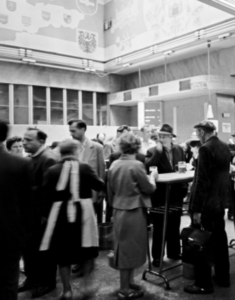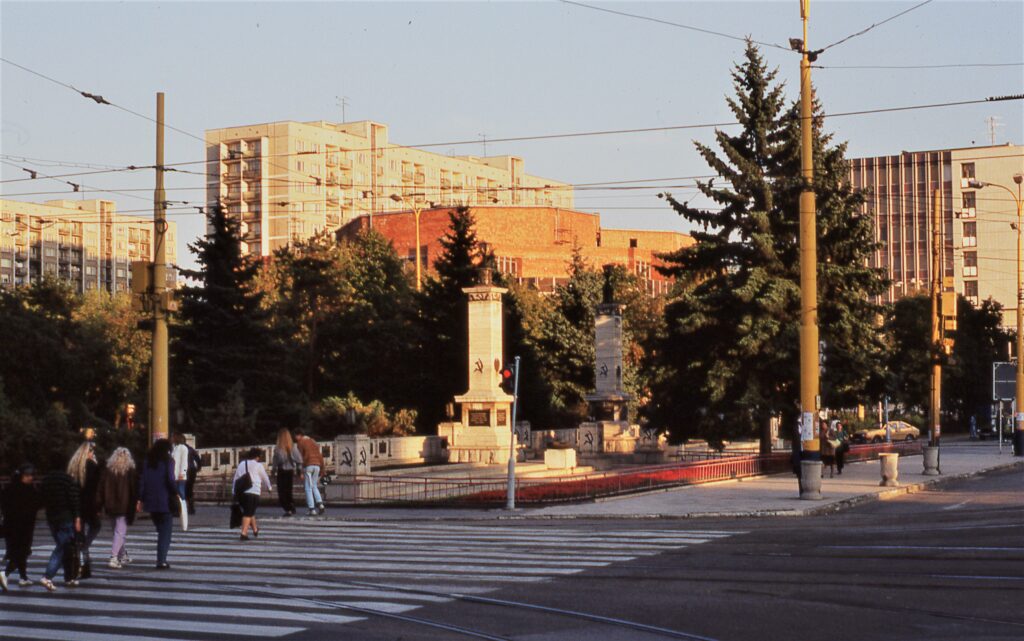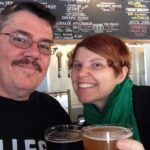
Previously: 40 Years in Beer, Part Thirty Four: In 1991, a smoky Bamberg sojourn with Happy Helmut.
On a sunny September morning in 1991, the train kept right on rolling.
Off to the north the majestic panorama of the High Tatras, the only range in the mysterious Carpathians to possess an Alpine character, gradually came into view. In black of night we had departed Prague, passing through the traditional Czech lands of Bohemia and Moravia, and crossing into Slovakia—at this time still a constituent of Czechoslovakia, although destined soon to become independent.

I’d come to this juncture after five weeks of wandering: Vienna to Munich, Regensburg to Bamberg, then continuing north to Copenhagen for a pleasant conclave with my Danish brethren. Afterwards the trail slipped back into northeastern Germany (formerly East Germany) to visit Suzanne, my workmate from the 1989 FDJ summer volunteer program, see a few sights with her, and meet her gracious parents.

All these years later, I can still taste mom’s amazing herring salad, redolent with garlic and onion.
During a nostalgic interlude in Berlin, I was loitering at a bar somewhere near Zoo Station, beer in hand, when word came that a coup against Mikhail Gorbachev was underway in the Soviet Union. It quickly failed, although the dissolution of the USSR was made inevitable, and the episode was all more unsettling having just returned from a jaunt to Potsdam, where bedraggled Soviet soldiers remained in their barracks more than a year after German unification, waiting to return home, their pockets filled with useless rubles, killing time by staring forlornly into shop windows filled with items they couldn’t dream of affording.
Stays in Dresden and Prague followed, and now it was morning near the Tatras. I dug into my pack for water, salami and cookies, consuming them while standing by the window in the corridor, soaking in the mountain scenery.
Three hours later the train made its final stop in Košice, where the prevailing mood was so very detached from Prague’s newly evolving cosmopolitan tourist vibe that a history buff like me could almost smell eau de collective farm from 60 miles away in the Ukraine, and taste an abundance of goulash-borne paprika in nearby Hungary.

It seems that during the early 1970s Košice’s main rail station was modernized via accepted contemporary communist design principles, and in 1991 it looked all the sadder for it; water leaked from nowhere into puddles, while stray rebar struggled to escape cracking, fissured cement. Windows needed washing, and ticket windows staffing.
Out in front by the tram and bus stops reposed the usual array of food, drink, flower and knick-knack kiosks intended to serve daily commuters, these well-worn spots occupied already by the usual local luminaries draining foamy mugs of their breakfast amid plumes of acrid cigarette smoke, which a cool breeze dispersed periodically to yield delectable whiffs of grilled sausages.

I joined them for a quick nibble and some liquid courage, subduing my rampant nervousness with bottled beer from some Slovak brewery I’d never heard of, but imagined I’d soon be purchasing religiously (Zlatý Bažant, a.k.a. Golden Pheasant, and my guess was correct). By then it was time to begin the perpetually maddening search for a pay phone that actually worked.
Evidently I found it, and the call evidently went through, because at some point after my second beer a youthful physician materialized. He’d been chosen to play taxi driver and collect me by virtue of owning a reasonably new car. It surprised me later when I learned that some of his colleagues did not possess internal combustion capability at all, and rode the tram to surgery.
How non-American could it possibly get? Well, consider this: there wasn’t even a golf course in the city.
As we conversed haltingly in English, Martin flew through the old town to the west and shot up the ridge into 1960s- and 70s-era prefabricated paneláks (high-rise apartment buildings in the “burbs”), past the imposing university hospital complex to an unassuming eight-story structure surrounded by a leafy and quiet side streets, known colloquially as “hospital hotel” (Považská 1969/40A, 040 11 Košice), where temporarily employed health care workers and visiting dignitaries were housed—as well newly arrived American-style conversational English instructors in desperate need of a shower and clean clothes.
I reeked of stale tobacco and airborne grease, because the previous evening in Prague had been a rough one. Prior to catching my late evening train in Prague, I’d checked my bags at the central station and proceeded to the legendary Automat Koruna on Wenceslas Square for a cheap parting meal amid typically colorful denizens of high society (in such a low place).
Truthfully, I was readying to exit for a refreshing walk before my train’s departure when a boisterous troupe of traveling Canadians gathered, asking if they could congregate at my stand-up stainless steel table, which led to just one more stolid draft Pražan golden lager, followed by a predictably mounting tally of half-liter drafts.
Lured by bargain basement prices, the Canadians kept buying—and I kept drinking, keeping an eye focused on my watch.

Never before had I lingered so late into the evening at the Automat, where the eatery’s supposed restrooms had always remained a closely guarded state secret. Instead, patrons typically shrugged and used the escalator located just outside the front door to descend to public toilets at the adjacent subway stop, but on this benedictory evening in question, these restrooms suddenly were closed up tight.
The Canadians quickly devised a pragmatic (albeit inelegant and profoundly unhygienic) solution—and I’ll stop there. It was a tad embarrassing, but as the sage once observed, a bladder filled to bursting has no conscience. But at least the subway itself wasn’t soiled, and brought me quickly to my rail platform, which is all that really mattered given that a couchette awaited to harbor impending unconsciousness.
It is worth noting that this night in 1991 was my last ever at the Automat Koruna, a haven for sustenance over the years. It began existence between the wars as exactly that: an automat, where diners inserted coins and items were vended from rows of slots similar to mailboxes in the post office, although humans still were necessary to load the chutes, pour beers and coffee, and assemble the eatery’s legendary strawberry milkshakes.
Only later during communism was the Automat retrofitted into a proletarian cafeteria, where a platter of roasted pork, dumplings, gravy and kraut accompanied by two drafts set you back the equivalent of just three or four bucks. On a later trip to Prague, circa 1995, I saw that the Automat was gone, unceremoniously upgraded into a name-brand Western blue jeans boutique.
And so, having traversed the length of Czechoslovakia and arrived at last in Košice, my late summer days to come would be devoted to wading through work permits and paperwork at the central police station, and then again at the hospital’s payroll department, while slowly learning to navigate a city I’d never before visited, as assisted by a handful of medical professionals who’d been assigned as liaisons to help me get settled so the actual teaching could begin.
Henceforth these folks would become my students, although perhaps this term implies a level of proficiency that I never genuinely managed. However, recall that a hefty dollop of opportunistic amateurism was hard-wired into the ongoing, improvisational program of Education for Democracy, the DIY organization that linked me with the teaching hospital in Košice and its chief, Dr. Robert Roland, who somewhat unexpectedly had been called upon to embrace the Sisyphean task of steering the facility into a new post-communist era.

From the outset I correctly divined that during my time in Košice, I’d be regarded as the hospital’s pet American, available as a symbol and reference source; as a bonus, maybe I’d be capable of imparting selected aspects of conversational English to doctors, nurses and administrators. I was capable of such, albeit only barely, proceeding to bluff my way through the rudiments of a syllabus of my own creation on a daily basis, deploying as props a dictionary, an almanac and pre-printed lyrics by John Mellencamp and Bruce Springsteen.
A cursory glance at Košice’s coordinates on a European map verified that unlike those denizens of the former Warsaw Pact who lived nearer the bloc’s boundaries with the West, Slovaks residing ten hours by rail east of Prague during pre-internet times experienced far fewer opportunities to interact with Americans in any way.
In fact, some of my students had never even spoken to an American, and much to my surprise, I became a sought-after novelty.
Had my natural inclinations been less shy or respectful of boundaries, being the new American on the block might have gone straight to my noggin. It didn’t, at least not very often, and when it did, I’m confident the motivations for interplay were purely mutual.
In the end, I surely learned more than my pupils, and I can only hope they benefited from knowing me.

One of the first tasks while reconnoitering my new neighborhood in Košice was finding the closest source of packaged beer, which proved to be a newly privatized grocery just around the corner from my building. The selection of beer brands in half-liter returnable glass bottles varied from day to day, although Budvar and Pilsner Urquell happily appeared often.
How does two for a dollar sound?
The grocery offered huge loaves of local rye and pumpernickel breads, regular supplies of produce (mostly potatoes, carrots, cabbage and onions) as well as old-school canned goods like Soviet mackerel and an odd but tasty vegetarian spread (for cold sandwiches), as well as glass jars of a bizarrely flavorful sauerkraut goulash with mystery meat, which I could heat on the stove down the hall, although there weren’t implements enough for more elaborate cooking. Maybe I didn’t get the memo: BYOS (Bring Your Own Spatula).
It also may have been the first grocery in Košice to stock packages of instant ramen from Malaysia and Singapore; I’ve no idea how they did it, but it is quite likely I was their best customer. Then again, having $100 traveler’s checks for emergency cash infusions, I could more easily afford 75 cents for a bowl of noodles than most of my students.
Pubs as such did not yet exist in the immediate vicinity of my residence, but a few blocks down the primary suburban thoroughfare, near the palatial former communist party headquarters known as the White House, there was a restaurant with draft beer. Outdoor kiosks like those at the train station came and went throughout my stay, as it was less troublesome to plant a shack outdoors on imperfectly defined “public” land than negotiate newfangled leases inside bricks ‘n’ mortar.
In the opposite direction from my quarters, over the lip of the ridge, a narrow path pretending to serve as a back street tumbled straight downhill through a small Romani district of free-standing houses where something always seemed to be burning (stoves, grills or trash), and just beyond them stood Košice’s 19th century city brewery, which appeared to have been an architectural showcase at one time, but by 1991 was crumbling by the minute, although still capable of producing inexpensive, pedestrian lagers that tasted like extract beer, as opposed to all grain.
Truth be told, the price was right, and I drank them anyway. The brewery closed long ago, and in recent years the property has been redeveloped into a sleek, modernistic mixed-use neighborhood.

(As an aside, the complicated experience of the Romani people, known also as Roma, in Košice and environs lies beyond the scope of the present account. However, those Roma living over the hill from my residence evidently were among the few who hadn’t been herded by the communist regime into paneláks in the outyling district called Luník IX, which even after more than 40 years and the advent of Slovakia’s membership in the European Union, remains one of the continent’s most infamous slums. Almost unanimously, my students blamed the Roma for their own wretched poverty and unemployment.)
Past the brewery a narrow zone of newer paneláks abruptly gave way to the historical center of Košice, a jumbled collection of Renaissance, Baroque, Rococo and Art Nouveau buildings occupying a few blocks on either side of a wide north-south main street that parted in the very center of the city to accommodate the medieval Cathedral of St. Elizabeth (Slovakia’s largest), a 19th century state theater, the gimmicky but cherished “singing” water fountain, and some park-like greenery.
It was a short walk from my room to the center, no more than 15 minutes, often undertaken for the express purpose of combining exercise with a visit to the Hotel Slovan at the south end of the old town, which was the only place in Košice to buy an International Herald Tribune newspaper.

It bears mentioning that an embryonic satellite feed brought European (western and eastern) and British news and entertainment programs to the television room at my lodging, and more importantly, the providential post-communist start-up radio station Rock-FM, relayed by satellite from Bratislava to Košice, became my lifeline to contemporary music, though only after I’d invested in a South Korean-made boom box at the Prior department store (it cost half of a physician’s monthly wage).
Nirvana and Pearl Jam, as well as the contrasting sounds of Crowded House’s Woodface, XTC and Jesus Jones (not to mention Casey Kasem’s weekly “Top 40”), first came to my attention via Rock-FM, which aired music in hour-long “themed” blocks of rock, pop, country and jazz. I had shipped cassettes to Košice along with books, and they were waiting upon arrival.

During the months to come, there’d be a few road trips and excursions, but in the main I was content to be a homebody, settling into perhaps the best opportunity I’d ever experienced as an adult to live all over again as an only child, keeping my own company and indulging my innate, lifelong melancholia through the usual channels of beer, food, reading and solitary strolling.
In summary, the historic center of Košice was chipped, faded, frayed and beautiful. These oldest sections of the city were situated in a narrow valley, and the further one traveled from the center, the newer and more utilitarian the neighborhoods became, pre-fabricated paneláks radiating outward and bunched together on higher ground, appearing from afar almost as if they comprised concrete walls encircling the city.
Czechoslovak president Vaclav Havel called them “rabbit hutches.” They were home to a majority of Košice’s 235,000 residents in 1991 (up from a mere 60,000 in 1950), and surely still are. The rapid population growth leading to their construction occurred because of overt social engineering. Jobs in communist countries tended to be old-school heavy industrial, and heavy industry meant steel, concrete, machinery, vehicles—not consumer goods, which always lagged behind.
Bohemia and Moravia had been industrialized in the mid-19th century when ruled by the Habsburg empire, and so during Czechoslovakia’s post-WWII decades as a newly communist state its central planners sought to “modernize” the more agricultural Slovak lands to the east by means of heavy industry, while simultaneously mechanizing farming, which made farm workers redundant and drove them into the cities to be employed in the factories—and live in the paneláks.
Košice’s biggest employer during my stay was Východoslovenské železiarne (VSŽ) Košice, the steel plant established in 1965. When Slovakia became independent in 1993, VSŽ produced 9% of the country’s GDP and generated 12% of its exports. In 2023, known as U. S. Steel Košice for almost 25 years, the plant still employees 9,000.
As a blue-collar factory town, Košice reveled in athletic competitions with other Slovak cities in football (soccer) and ice hockey, with the latter boasting stereotypically ill-tempered rhubarbs throughout. But there was a white collar side, too, in the form of several institutions of higher learning, as well as a technical university. The oldest, Universitas Cassoviensis, dated to 1657 during the time of Hungarian hegemony, and included the medical faculty of Pavol Jozef Safarik University—in effect, my employer.

Indeed, Košice proved to be an intriguing locale, and I never lacked for interesting areas to explore. Among the outings undertaken outside the city during my six months of residency: the High Tatras for a “hike”; all the way back to Plzen in Bohemia to tour the Pilsner Urquell brewery for the first time; rustic Medzilaborce to the east for the opening of an Andy Warhol museum; Bratislava for a day with Dr. Roland, including mealtime beers at the legendary but long extinct Mammoth beer hall; and overnight to Budapest to take the US Foreign Service exam.
A far longer week in Rotterdam, Netherlands came in January of 1992, but that’s a story for its own chapter.
First, there was a night on the town.













































[…] Previously: 40 Years in Beer, Part Thirty Five: Košice comes into view and the Zlatý Bažant flows. […]
Comments are closed.